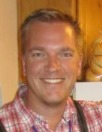 EMAIL
INTERVIEW
- Chad Vander Veen and Ken Sinclair
EMAIL
INTERVIEW
- Chad Vander Veen and Ken Sinclair
|
February 2014 |
[an error occurred while processing this directive] |
| |
 EMAIL
INTERVIEW
- Chad Vander Veen and Ken Sinclair
EMAIL
INTERVIEW
- Chad Vander Veen and Ken Sinclair
Chad Vander Veen, Editor, FutureStructure
Graduated University of Redlands in
2001 with a degree in Government
Was Associate Editor of Government Technology magazine from 2005-2012
Served as Public Information Officer at the California High-Speed Rail
Authority in 2013
Currently Editor of FutureStucture.com
Was a candidate for the California State Assembly in 2010 (I lost)
| Articles |
| Interviews |
| Releases |
| New Products |
| Reviews |
| [an error occurred while processing this directive] |
| Editorial |
| Events |
| Sponsors |
| Site Search |
| Newsletters |
| [an error occurred while processing this directive] |
| Archives |
| Past Issues |
| Home |
| Editors |
| eDucation |
| [an error occurred while processing this directive] |
| Training |
| Links |
| Software |
| Subscribe |
| [an error occurred while processing this directive] |
Sinclair:
What is FutureStructure?
Vander Veen: FutureStructure
is a new framework for thinking through and solving the
challenges faced in building economically and socially robust
communities. FutureStructure is about what we build, how we build and
how the things we build connect with everything else.
Sinclair: What is the mission or vision for FutureStructure?
Vander Veen:
FutureStructure is e.Republic’s
effort to help city and regional
leaders understand that cities are not a collection of independent
silos. Cities in reality are large-scale, interconnected systems.
Everything in a city/region is connected. By exposing how things are –
or can be – connected, more intelligent decisions can be made that will
create communities that are better for the people who live in them.
Think of the human body. You have an
energy system, a water system, a
waste removal system, a transportation system and an existing
infrastructure (or built environment). Depending on who we are, our
infrastructure might be in great condition or it might need some help.
All those other systems support the infrastructure of you. If you only
concern yourself with one, say, energy, then the rest will suffer. But
when you understand how you function as a system, you can make better
decisions. Now, add a layer of technology to that and a whole host of
new possibilities arise.
It’s the same with a city. We want
government to think like a systems
engineer. To do that we believe there are three concepts to understand:
Sinclair:
What are the technologies in
FutureStructure?
Vander Veen: There are a number of key technologies that will drive FutureStructure. Some of these include: Big Data, Business Intelligence, Mobile Tech, Next-Gen Networks, Location Data/Intelligence, Remote and Embedded Sensors, the Internet of Things, Data Analytics, GIS, Wearable Tech, Cloud Computing, 3D Printing and any technology solution that either helps what we build connect or helps leaders understand those connections.
Sinclair:
Where do smart buildings fit into the
FutureStructure framework?
Vander Veen:
Smart buildings, along with intelligent transportation systems, are the
real tangible outcomes of thinking of cities as systems. These are the
things people can see, feel, use and understand just by looking at
them. Many of us spend much of our time indoors but we often don’t
realize that the building we inhabit is part of a larger system. In
most cases, that building only takes from the system in terms of energy
and produces a lot of waste. But if we make or build smarter buildings,
those places we inhabit can generate energy. Even the waste a building
generates can be managed more intelligently so it actually becomes an
energy resource. Smart buildings become nodes on a network of
distributed energy generators that contribute to making the communities
they exist in better and cleaner.
[an error occurred while processing this directive]Sinclair:
Can you give an example of
FutureStructure in action?
Vander Veen:
Sure. In this story I wrote about Sacramento, Calif.’s efforts around
“Farm-to-Fork-to-Fuel.” What’s happening there is that commercial food
companies and city restaurants have partnered with a local waste
management company to use organic food waste to produce renewable
natural gas using a machine called an anaerobic digester. The natural
gas is purchased by fleets, including the city of Sacramento, to fuel
heavy vehicles like buses, trash trucks and street sweepers. The
leftover solids from the process are then sold to area farmers as a
high-grade compost, resulting in a closed-loop system that impacts
energy, transportation, and waste while also improving regional
sustainability and resiliency.
Sinclair:
What’s in store for FutureStructure
this year?
And as editor I’m always on the lookout
for smart, passionate people
for whom the vision of FutureStructure resonates. So if this is
something you the reader would be interested writing about or if you
have a story you think would be a good fit, my email inbox is always
open at cvanderveen@erepublic.com.
[an error occurred while processing this directive]
[Click Banner To Learn More]
[Home Page] [The Automator] [About] [Subscribe ] [Contact Us]